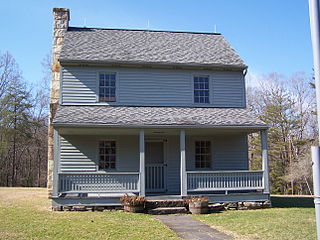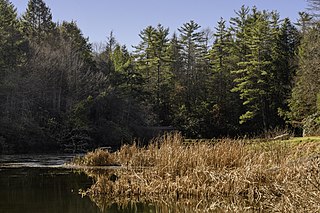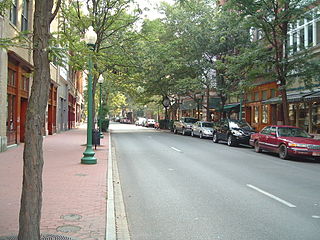
Charleston is the capital and most populous city of West Virginia. Located at the confluence of the Elk and Kanawha rivers, the city had a population of 51,400 at the 2010 census and an estimated population of 46,536 in 2019. The Charleston metropolitan area as a whole had an estimated 208,089 residents in 2019. Charleston is the center of government, commerce, and industry for Kanawha County, of which it is the county seat.

William Alexander MacCorkle, was a United States teacher, lawyer, prosecutor, the ninth Governor of West Virginia and state legislator of West Virginia, and financier.

The University of Charleston (UC) is a private non-profit university with its main campus in Charleston, West Virginia. The university also has a location in Beckley, West Virginia, known as UC-Beckley.

Droop Mountain Battlefield State Park is a state park located on Droop Mountain in Pocahontas County, West Virginia. The park was the site of the Battle of Droop Mountain, the last major battle of the American Civil War in the state taking place on November 6, 1863. John D. Sutton, a West Virginia private in the Union Army at the battle, became the leader in the movement to create the park when he served in the West Virginia House of Delegates. Dedicated on July 4, 1928, Droop Mountain Battlefield became the first state park in West Virginia.

The West Virginia State Capitol is the seat of government for the U.S. state of West Virginia, and houses the West Virginia Legislature and the office of the Governor of West Virginia. Located in Charleston, West Virginia, the building was dedicated in 1932. Along with the West Virginia Executive Mansion it is part of the West Virginia Capitol Complex, a historic district listed on the National Register of Historic Places.

Carnifex Ferry Battlefield State Park is an American Civil War battle site that commemorates the Battle of Carnifex Ferry. It is located on the rim of the Gauley River Canyon near Summersville, a town in Nicholas County, West Virginia. The 156-acre (0.63 km2) park features Patterson House Museum, three views of the Gauley River, hiking trails and picnic facilities. It is one of the oldest state parks in the United States. A Civil War re-enactment takes place on a weekend after Labor Day. As Carnifex Ferry State Park, it was listed on the National Register of Historic Places in 1974.

Little Beaver State Park is state park in Raleigh County, West Virginia. It is located near Beckley, West Virginia, about 2 miles (3.2 km) south of I-64 at Grandview Road, exit 129A. The park sits on the shores of 18-acre (0.07 km²) Little Beaver Lake.
Malden — originally called Kanawha Salines — is an unincorporated community in Kanawha County, West Virginia, United States, within the Charleston metro area.

Charleston station is an Amtrak station in Charleston, West Virginia, United States, that is listed on the National Register of Historic Places and is served by the Cardinal. The Cardinal operates as Train 50 Eastbound towards Washington D.C. and New York City departing Chicago on Saturdays, Tuesdays, and Thursdays. The train operates as Train 51 Westbound towards Chicago departing New York on Wednesdays, Fridays, and Sundays. Trains only operate to the station on Wednesdays, Fridays, and Sundays.

St. John's Episcopal Church is an historic Episcopal church located at 1105 Quarrier Street in Charleston, West Virginia, in the United States. On November 2, 1989, it was added to the National Register of Historic Places. It was also listed as a contributing property in the Downtown Charleston Historic District in 2006.

Craik-Patton House is a historic home located at Charleston, West Virginia. It was built by James Craik and his wife, Juliet Shrewsbury, in 1834 in the Greek Revival style. It was originally located on Virginia Street in Charleston, but moved to its present site in 1973 to save it from the threat of demolition. It features four massive columns that support the extended center roof with pilasters placed above the front facade. It was faithfully restored and preserved for the public by the National Society of the Colonial Dames of America in the state of West Virginia and open for tours year round.

Littlepage Stone Mansion, also known as The Old Stone Mansion, is a historic home located at Charleston, West Virginia. It was constructed in 1845 is one of only six houses within the City of Charleston that date to before the American Civil War. It was originally constructed as a two-story Federal style residence, with additions and improvements made in 1915 and 1936.

Sunrise, also known as MacCorkle Mansion, is a historic home located at Charleston, West Virginia. It was built in 1905 by West Virginia's ninth governor, William A. MacCorkle (1857-1930). It is a long, three-story stone mansion. Its gabled roof is dotted with dormers and chimneys and surmounts an intricate, but wide, cornice which gives the illusion that the house is smaller than it actually is. The Georgian structure rests on a bluff overlooking the Kanawha River, and from the northern portico one can see nearly the entire city of Charleston. The north side features four magnificent Doric, or neo-classic, columns which support the cornice and ashlar-finished pediment. In 1961 Sunrise Foundation, Inc., was formed for the purpose of purchasing the mansion and grounds.

Downtown Charleston Historic District is a national historic district located at Charleston, West Virginia, USA. The district contains contributing structures in the Late Victorian and Late 19th and 20th Century Revivals architectural styles. St. John's Episcopal Church (1884), the Basilica of the Co-Cathedral of the Sacred Heart (1897), and Woodrums' Building (1916) are contributing properties.

The Trump–Lilly Farmstead is a historic farmstead located near Hinton, in Raleigh and Summers County, West Virginia. The property includes seven contributing buildings and one contributing site, representative of a frontier Appalachian farm. The main house is a typical two-story southern farmhouse with a side-gabled roof. The farm was sold to the National Park Service in 1988.

The West Virginia Capitol Complex is a 18-acre (7.3 ha) historic district located along Kanawha Blvd., E., in Charleston, West Virginia. It dates from 1925 and was listed on the National Register of Historic Places in 1974.

Rogers House is a historic home located at Morgantown, Monongalia County, West Virginia. It was originally built about 1857 and is one of the last remaining residences from this time period in downtown Morgantown. The building is a two-story, five bay brick and wood frame dwelling in the Classical Revival style. The original section of the house is in brick, whereas the addition, designed by noted Morgantown architect Elmer F. Jacobs and built in 1905-1906 is wood frame. Jacobs is also responsible for the interior design. It sits on a rough-faced coursed ashlar stone foundation. It features a front porch with four sets of triple wooden, Tuscan order columns. It was the home of the Rogers family, pioneer settlers of Morgantown. It has been the home of West Virginia University's Campus Ministry Center since 1984. It was listed on the National Register of Historic Places in 1984. It is located in the Downtown Morgantown Historic District, listed in 1996.
Sugar Grove is a community located in Pendleton County, West Virginia, United States. Its ZIP Code is 26815. It is located within the United States National Radio Quiet Zone.

The Summers House is a historic house located at 805 Loudon Heights Road in Charleston, West Virginia. Elizabeth and Okey Summers had the house built circa 1939; Elizabeth was active in theater, while Okey was a prominent local banker. The house was part of Charleston's upper-class South Hills neighborhood, and its site was a former stone quarry that was solid rock prior to the house's construction; the sandstone from the quarry was used as the house's building material. Architect Charles A. Havilant, a prolific local architect responsible for many of the city's homes and civic institutions, designed the Tudor Revival home. The house lacks many of the typical characteristics of Tudor architecture, such as a steep roof and half-timbering, due to Elizabeth's preference and the limitations of the site; its prominent features include tall chimneys, casement windows with diamond-shaped leaded glass panels, and a cathedral ceiling.
Walter Frederic Martens was an American architect who worked mainly in West Virginia. He is best known for building the West Virginia Governor's Mansion (1926).




















